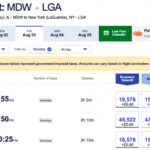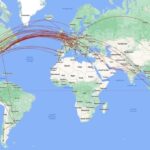Round The World Trip Budget: Dreaming of circumnavigating the globe? The allure of adventure is undeniable, but the financial reality can be daunting. This comprehensive guide demystifies the process, offering practical strategies to plan a trip that fits your budget, whether you’re a budget backpacker or a luxury traveler. We’ll dissect every aspect, from flights and accommodation to food, activities, and unexpected expenses, empowering you to make informed decisions and turn your dream into a reality.
This isn’t just about numbers; it’s about maximizing your experience while minimizing financial stress. We’ll explore various booking methods, accommodation options, and cost-saving tips for food and activities. Learn how to leverage frequent flyer miles, negotiate transportation costs, and secure the right travel insurance. Prepare to discover hidden gems and unlock the secrets to affordable global exploration.
Defining a Realistic Budget

Planning a round-the-world trip is exhilarating, but without a solid budget, that excitement can quickly turn into financial stress. A well-defined budget isn’t about restricting your adventures; it’s about maximizing your experience within your means. This section will guide you through creating a realistic budget, ensuring you can explore the globe without emptying your bank account.
Essential Travel Expenses Categorized by Budget Level
Understanding the cost spectrum is crucial. A round-the-world trip can be tailored to various budgets, from budget-conscious backpacking to luxurious globetrotting. Let’s break down essential expenses across three tiers: budget, mid-range, and luxury. Remember, these are estimations and can vary significantly based on your travel style and destinations.
| Item | Category | Budget (USD/day) | Mid-Range (USD/day) | Luxury (USD/day) |
|---|---|---|---|---|
| Flights | Transportation | $50 – $100 | $150 – $300 | $500+ |
| Accommodation | Accommodation | $20 – $40 (hostels, guesthouses) | $50 – $100 (mid-range hotels, Airbnb) | $150+ (luxury hotels, resorts) |
| Food | Food & Drink | $25 – $50 (street food, local markets) | $50 – $100 (restaurants, cafes) | $100+ (fine dining) |
| Activities & Entrance Fees | Activities | $10 – $30 | $30 – $70 | $100+ |
| Transportation (Local) | Transportation | $10 – $20 (buses, trains) | $20 – $40 (taxis, private transport) | $50+ (private cars, first-class trains) |
| Visa Fees | Miscellaneous | $50 – $150 (depending on destinations) | $50 – $150 (depending on destinations) | $50 – $150 (depending on destinations) |
| Miscellaneous (Souvenirs, etc.) | Miscellaneous | $20 – $40 | $40 – $80 | $100+ |
Sample Budget Spreadsheet
A spreadsheet is invaluable for tracking expenses. Here’s a basic template you can adapt:
| Item | Category | Estimated Cost (USD) | Actual Cost (USD) |
|---|---|---|---|
| Flights | Transportation | ||
| Accommodation (Month 1) | Accommodation | ||
| Food (Month 1) | Food & Drink | ||
| Activities (Month 1) | Activities | ||
| Local Transport (Month 1) | Transportation |
Unexpected Costs and Contingency Funds
Unexpected costs are inevitable. Medical emergencies, flight delays, lost luggage—these can significantly impact your budget. Always include a contingency fund. A general rule of thumb is to allocate 20-30% of your total estimated budget for unforeseen circumstances. For example, if your estimated budget is $10,000, allocate $2,000-$3,000 as a contingency fund.
Impact of Travel Season on Trip Costs
Travel during peak season (typically summer months in the Northern Hemisphere) generally leads to higher prices for flights and accommodation. Off-season travel can significantly reduce your costs. Research the best time to visit your chosen destinations to optimize your budget. For instance, traveling to Southeast Asia during the shoulder seasons (spring and autumn) offers pleasant weather and lower prices compared to the peak season.
Flight Costs and Strategies: Round The World Trip Budget
Planning the flight portion of your round-the-world trip requires a strategic approach. Failing to meticulously plan this aspect can significantly inflate your overall budget, potentially derailing your entire adventure. Understanding the nuances of flight booking, leveraging various strategies, and maximizing rewards programs are crucial for keeping your airfare costs under control.
Flight Booking Strategies Compared
Choosing the right method for booking flights is paramount. Three primary approaches exist: using flight comparison websites, booking directly with airlines, and employing the services of a travel agent. Each option presents distinct advantages and disadvantages that must be carefully weighed against your individual needs and travel style.
- Flight Comparison Websites: These platforms (like Google Flights, Skyscanner, Kayak) aggregate flight data from numerous airlines, allowing for easy price comparison. The advantage is the breadth of options and the potential to find significantly cheaper fares. However, the downside is the lack of personalized service and potential for hidden fees. You’re responsible for navigating the booking process independently.
- Booking Directly with Airlines: Booking directly offers more control and potentially better customer service, especially if issues arise. Airlines often have their own loyalty programs, which can provide benefits like priority boarding and baggage allowances. The drawback is the lack of a comprehensive price comparison across all airlines.
- Travel Agents: Travel agents offer a personalized service, handling the complexities of booking multiple flights and potentially securing better deals through their industry connections. However, this service typically comes at a cost, with agent fees adding to your overall expenses. This is often the best option for complex itineraries or those lacking time or expertise in booking flights.
Round-the-World Tickets vs. Individual Flights
The decision between purchasing a round-the-world (RTW) ticket and booking individual flights depends on your itinerary’s flexibility and complexity.
- Round-the-World Tickets: RTW tickets, offered by airlines like Star Alliance or OneWorld, provide a fixed itinerary with pre-determined flight segments. The advantage is often a lower overall cost compared to booking individual flights, especially for longer trips. The disadvantage is the lack of flexibility; changing your plans might incur significant penalties.
- Individual Flights: Booking individual flights offers greater flexibility, allowing you to adjust your itinerary as needed. However, this approach can be more expensive and requires more time and effort to research and book each flight segment. Finding the best deals requires significant effort and may not always yield the lowest overall price.
Potential Flight Cost Savings
The following table illustrates potential savings based on booking methods and travel times. These are illustrative examples and actual savings may vary significantly based on specific routes, airlines, and booking times.
| Booking Method | Time of Year | Example Route (New York – London – Paris – New York) | Estimated Cost | Potential Savings vs. Peak Season Direct Booking |
|---|---|---|---|---|
| Flight Comparison Website | Shoulder Season (April/May or September/October) | New York – London – Paris – New York | $1,500 | $500 |
| Direct Booking with Airline (using miles) | Shoulder Season (April/May or September/October) | New York – London – Paris – New York | $1,200 | $800 |
| Travel Agent (negotiated package) | Off-Season (November – March) | New York – London – Paris – New York | $1,800 | $200 (compared to off-season direct booking) |
| Direct Booking | Peak Season (June-August) | New York – London – Paris – New York | $2,000 | N/A |
Maximizing Frequent Flyer Miles and Loyalty Programs, Round The World Trip Budget
Leveraging frequent flyer miles and loyalty programs is a powerful strategy for reducing flight costs. Many airlines offer bonus miles for spending on affiliated credit cards or for reaching certain spending thresholds. Careful planning and strategic use of these programs can result in significant savings, potentially even covering the cost of several flights. For example, a traveler who consistently uses a particular airline’s credit card and flies with them regularly can accumulate enough miles to redeem for free or discounted flights, significantly reducing the overall cost of their round-the-world journey.
This strategy requires consistent effort and careful planning but offers substantial long-term rewards.
Activities and Entertainment
Unlocking the world’s wonders doesn’t require emptying your bank account. Smart travelers know that unforgettable experiences can be had on a shoestring budget, transforming a potentially expensive trip into an adventure brimming with cultural immersion and personal growth. By strategically planning your activities and entertainment, you can maximize your enjoyment while staying within your financial constraints. This section will equip you with the knowledge to do just that.
Balancing sightseeing with relaxation is crucial for a fulfilling trip. Over-scheduling can lead to burnout and a less-than-optimal travel experience. The key is to integrate downtime into your itinerary, allowing for spontaneous moments of discovery and the opportunity to simply absorb your surroundings. This not only enhances your enjoyment but also helps prevent unexpected expenses associated with fatigue and impulsive decisions.
Free and Low-Cost Activities Around the World
Numerous free or low-cost activities are available globally. These opportunities enrich your travel experience without significantly impacting your budget. Prioritize these options to maximize your adventure while minimizing costs.
- Hiking and Nature Walks: Explore breathtaking landscapes worldwide without spending a dime. From the Appalachian Trail in the US to the Inca Trail in Peru (permit required, but significantly cheaper than guided tours), the natural world offers countless free adventures.
- Free Museums and Galleries: Many museums offer free admission days or evenings, particularly smaller, local institutions. Research your destinations in advance to identify these opportunities. For example, many museums in Europe offer free admission on specific days or for certain age groups.
- Local Events and Festivals: Immerse yourself in the local culture by attending free community events, festivals, or markets. These offer authentic experiences and often feature local food and entertainment.
- Parks and Public Spaces: Enjoy picnics in beautiful parks, relax by the beach, or explore vibrant city squares. These free options offer a chance to unwind and observe local life.
Budget-Friendly Entertainment Options by Region
Careful planning can significantly reduce entertainment costs. Consider these region-specific examples:
- Southeast Asia: Street food markets offer delicious and incredibly affordable meals. Enjoy vibrant night markets, explore ancient temples (entrance fees are often minimal), and take advantage of inexpensive local transportation like tuk-tuks for short distances.
- South America: Hike to stunning viewpoints, explore free walking tours in major cities like Buenos Aires or Medellín, and enjoy the lively atmosphere of local plazas and parks. Many smaller towns offer affordable homestays and opportunities to interact with locals.
- Europe: Take advantage of free walking tours in many major cities, visit free churches and cathedrals, and explore charming local neighborhoods. Pack your own lunches and snacks to save on food costs.
- North America: National Parks often have affordable or free entry on certain days. Explore hiking trails, visit state parks, and take advantage of free activities offered in many cities, such as outdoor concerts or farmers’ markets.
Setting a Daily or Weekly Budget for Activities and Entertainment
Establishing a daily or weekly budget is paramount. This helps prevent overspending and keeps your overall travel costs in check.
For example, allocate a specific amount for activities and entertainment each day or week. Track your spending diligently to ensure you remain within your budget. This disciplined approach prevents impulsive purchases and ensures you can enjoy your trip without the stress of financial strain. Consider using a budgeting app to track your spending and receive real-time updates on your remaining funds.
“A well-defined budget isn’t a restriction; it’s a roadmap to a richer, more fulfilling travel experience.”
Transportation and Getting Around

Navigating the globe on a budget requires a shrewd approach to transportation. The cost of getting from Point A to Point B can significantly impact your overall travel expenses. Understanding the nuances of different transportation methods and employing smart strategies is crucial for maximizing your adventure while minimizing financial strain. This section will dissect various transportation options, offering practical tips and a sample itinerary to illustrate cost-effective travel.Choosing the right mode of transportation depends heavily on your destination and travel style.
Factors like distance, travel time, comfort level, and local infrastructure all play a significant role. Failing to consider these variables can lead to unexpected expenses and travel delays.
Transportation Cost Comparison Across Regions
Different regions offer vastly different transportation options and pricing structures. In Southeast Asia, for instance, extensive and affordable bus networks crisscross the landscape, making them a far more economical choice than flights for shorter distances. A bus journey from Bangkok to Chiang Mai might cost around $10-20, while a flight could easily double or triple that price. Conversely, in vast countries like Australia or Canada, flying becomes a more practical option for long distances, although careful booking and comparison shopping are essential.
In Europe, high-speed trains offer a comfortable and often cost-effective alternative to budget airlines, especially for medium-distance travel between major cities. Ride-sharing services, while convenient, can be surprisingly expensive if not used strategically, particularly in urban areas with high demand. Always compare prices across all available options before committing to a specific mode of transport. Consider factors like travel time, comfort, and potential hidden fees.
Effective and Affordable Public Transportation Usage
Mastering public transportation is a cornerstone of budget travel. Before embarking on your journey, research the local transit systems thoroughly. Many cities offer day passes or multi-day passes that offer significant savings compared to individual ticket purchases. Utilize apps like Citymapper or Google Maps to plan your routes, check schedules, and identify the most efficient and cost-effective options.
Familiarize yourself with local customs and etiquette regarding public transport. For example, in some countries, it’s customary to purchase tickets in advance or validate them upon boarding. Ignoring these local norms can lead to fines or unexpected delays.
Negotiating Transportation Costs and Avoiding Scams
Negotiating fares is often possible, particularly with taxis and private drivers, especially in less developed regions. However, always be respectful and avoid aggressive haggling. Establish a fair price beforehand, ideally using a reliable price comparison app or consulting local resources. Be wary of scams, such as inflated fares or detours. Stick to reputable transportation services whenever possible, and if using ride-sharing apps, ensure you’re using the official app and not a counterfeit version.
Confirm the driver’s identity and vehicle details before getting in. In some regions, pre-booking transportation is essential, particularly for airport transfers or long-distance journeys, to avoid inflated on-the-spot prices.
Hypothetical Cost-Effective Itinerary: A Southeast Asia Example
Let’s imagine a two-week trip through Southeast Asia. The itinerary leverages a combination of transportation methods to minimize costs:Fly into Bangkok (Thailand). Utilize the extensive and affordable bus network to travel between Bangkok, Chiang Mai (Thailand), and Luang Prabang (Laos). For the journey from Luang Prabang to Hanoi (Vietnam), consider a slower, more scenic overnight bus or a budget flight, depending on time constraints and your preference.
Within Hanoi and other cities, utilize the local bus systems and walk whenever possible. For shorter hops between cities in Vietnam, consider trains, which often offer a comfortable and budget-friendly alternative to domestic flights. Finally, fly out from Ho Chi Minh City (Vietnam). This mixed approach balances speed and comfort with affordability, making the most of each region’s transportation infrastructure.
This approach demonstrates a practical strategy to minimize transportation costs while maximizing your travel experience.
Planning a round-the-world trip on a budget is achievable with meticulous planning and strategic choices. By understanding the various cost components, employing smart booking strategies, and embracing flexible travel styles, you can significantly reduce expenses without sacrificing the quality of your experience. Remember, the journey is as much about the destination as it is about the journey itself – and with the right approach, both can be incredibly rewarding.
So, start planning your adventure today! The world awaits.

